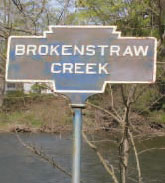Protecting Brokenstraw Watershed
In northwestern Pennsylvania, WPC is working with the Brokenstraw Watershed Council and other groups to protect a critical watershed that includes fen, forest and farm-rich habitat. One feature of the watershed is Spring Creek, a high-quality coldwater fishery prized for its population of wild brook trout and world-class black cherry timberlands.

While the Brokenstraw watershed has largely escaped the abandoned mine drainage that besets other parts of Pennsylvania, it has been impacted by agricultural runoff and soil erosion from logging operations. Fortunately, those problems can be easier to fix.
“The whole watershed is one of the cleaner ones draining into the Allegheny River, so a lot of what we’re doing is preservation,” said Nick Pinizzotto, WPC’s senior director, watershed conservation and conservation science. “That’s a whole lot easier and less costly than going into a watershed and performing a major overhaul. Sometimes it’s a matter of fencing barnyards or as simple as putting gutters on a barn. Farmers are usually interested in conservation, especially if you’re able to bring financial resources to help pay for improvements.”
Besides WPC and the Brokenstraw Watershed Council, support comes from the U.S. Department of Agriculture; Erie, Warren and Crawford county Conservation Districts; and other partners. A draft plan for the watershed, which incorporates historical land use data and public meetings held in recent months, should be completed by December, said Kylie Maland, WPC’s director of watershed planning. “We’ll give the public an opportunity to review and comment on the draft, and we’ll incorporate their recommendations into a final plan, which will be implemented by many groups over time.”

Some watershed improvements are already underway, including sedimentation control on logging roads, and the implementation of best farming practices to reduce nutrient overload and erosion on streams. Additionally, the watershed council has been working on invasive plant control, engaging youth groups and others in replacing unwanted species with natives for habitat protection and biodiversity.
“There aren’t many places like this left, and sometimes people don’t realize what they have until it’s too late,” said Karen Prather, president of the Brokenstraw Watershed Council. “A lot of our work is public education, starting with the tiniest children. We’re local people reaching out to neighbors. That’s very effective in building a community of people who care about the environment.”
Give your legacy roots
By including the WPC in your estate plans, such as through a bequest, a charitable gift annuity, or a gift of life insurance, you will ensure that our natural heritage is also a part of your future legacy.
